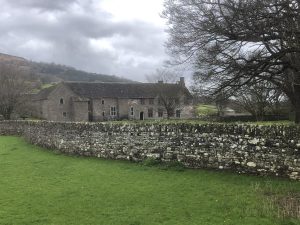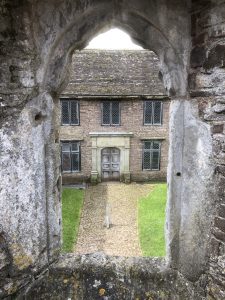Reduced to farm buildings, then left to wrack and ruin, the once-grand Tretower Court, in the Usk Valley, was saved for the nation in 1934 and is now in the safe hands of Cadw. The house has been beautifully restored and is presented to visitors with outstanding flair and imagination.
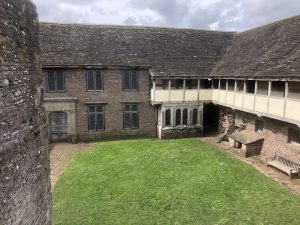 The two long ranges of Tretower Court, an attractive mixture of stone and timber-framing, were constructed in the mid-fifteenth century by Sir Roger Vaughan. It was either Sir Roger or his son, Sir Thomas, who added the battlemented curtain wall and gatehouse (with its huge wooden doors) to create the full courtyard plan of today.
The two long ranges of Tretower Court, an attractive mixture of stone and timber-framing, were constructed in the mid-fifteenth century by Sir Roger Vaughan. It was either Sir Roger or his son, Sir Thomas, who added the battlemented curtain wall and gatehouse (with its huge wooden doors) to create the full courtyard plan of today.
The charm of Tretower, apart from the tranquil courtyard, is that the north range is virtually unaltered. The apartments on its upper floor are still accessed through a wooden side gallery. The west range, attached to it at a right angle, probably looked rather similar, but has acquired the elegant, late seventeenth-century façade that is the first thing one sees through the entrance arch.
The interior is unchanged, however, with the kitchen and service rooms at one end and Roger Vaughan’s private quarters at the other. The centrally-placed great hall, with its large fireplace on the west wall, is open still to its gloriously timbered roof. The timbers have been dendro-dated to 1455-6.
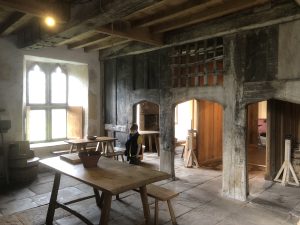 It was in this setting that Roger maintained ‘a court of royal style, the maintenance of a hundred men’. The wine flowed at his banquets and the itinerant ‘poets of the nobility’ were always on hand to sing his praises. Cadw have restored these rooms ‘as faithfully as possible, with new partitions, and plaster applied to the walls as appropriate’ (David M. Robinson, Tretower Court and Castle, Cadw, 2018, p.14). They have also filled them with replica furniture and fittings.
It was in this setting that Roger maintained ‘a court of royal style, the maintenance of a hundred men’. The wine flowed at his banquets and the itinerant ‘poets of the nobility’ were always on hand to sing his praises. Cadw have restored these rooms ‘as faithfully as possible, with new partitions, and plaster applied to the walls as appropriate’ (David M. Robinson, Tretower Court and Castle, Cadw, 2018, p.14). They have also filled them with replica furniture and fittings.
However well researched, such an approach is often deplored by purists, but for me, the result is very pleasing. There are hangings of say in the blue and red stripes of the Brigade of Guards, two trestle tables with benches arranged lengthwise for the retainers and, raised on a dais at the far end, a third table facing them which was for the lord and his family.
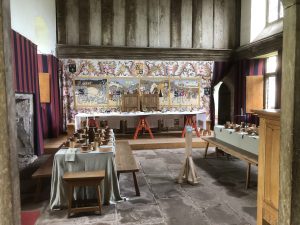 Covered with white table cloths, these are arrayed with glass- and pewter-ware and trenchers (slices of inferior bread that served as plates) that are less convincing. (They look like off-cuts from a breeze-block.) There are a dresser and a ‘cup board’ at the screen-end. With the aid of these props, it is quite easy to imagine the feasting and carousing that went on in this room.
Covered with white table cloths, these are arrayed with glass- and pewter-ware and trenchers (slices of inferior bread that served as plates) that are less convincing. (They look like off-cuts from a breeze-block.) There are a dresser and a ‘cup board’ at the screen-end. With the aid of these props, it is quite easy to imagine the feasting and carousing that went on in this room.
Best of all is a painted cloth behind the high table, specially commissioned by Cadw, that depicts incidents from the Vaughan family history. On the extreme left we see Sir Roger’s father, Roger Vaughan of Bredwardine in Herefordshire, and his maternal grandfather, Dafydd Gam (‘the one-eyed’), at the Battle of Agincourt, where both men perished. Dafydd has been suggested as Shakespeare’s model for Fluellen in Henry V. As a prominent opponent of Owain Glyndŵr, he is anathema to Welsh nationalists, but his family had served their English overlords for generations, and would never have regarded themselves as traitors.
Sir Roger’s mother, Dafydd Gam’s daughter Gwladus Dhu, was remarried to Sir William ap Thomas, whose first wife, a Bloet, had been the heiress to both Raglan and Tretower. Known as ‘y marchog glas o Went’ (the blue knight of Gwent), Sir William was chief steward to the lord of Usk – the English Duke of York – and a member of hi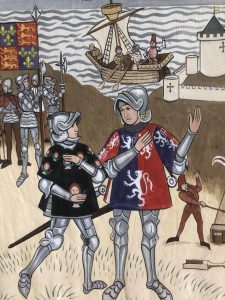 s military council. From 1432 he had begun the transformation of Raglan, raising the present South Gate and Great Tower, which was surely painted. The court poet Guto’r Glyn refers to this five-storey moated fortress, accessible only by a drawbridge, as the ‘Yellow Tower of Gwent’.
s military council. From 1432 he had begun the transformation of Raglan, raising the present South Gate and Great Tower, which was surely painted. The court poet Guto’r Glyn refers to this five-storey moated fortress, accessible only by a drawbridge, as the ‘Yellow Tower of Gwent’.
Presided over by the remarkable Gwladus, the whole family, including young Roger, had taken up residence in these spacious quarters. When Gwladus died in 1454, her funeral was attended by 3,000 mourners, for she had been ‘the strength and support of Gwentland and the land of Brychan’. The court poet Lewis Glyn Cothi refers to her as ‘y seren o Efenni’ (the star of Abergavenny), though elsewhere she is sun-like, a ‘pavilion of light’. They were a close and united family. Roger was particularly attached to his younger half-brother, William Herbert, the future Earl of Pembroke, who on succeeding his father in 1445, settled Roger at Tretower as his castellan.
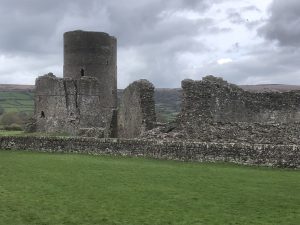 The motte-and-bailey castle of the Picards and Bloets stood in flat meadowland. The old shell keep had been gutted in the mid-thirteenth century and a great round ‘tower’ (from which Tretower is named) had been raised within. The polygonal outer walls of the shell keep had been retained, however, to form an impressive outer defence. Tretower Court is the comfortable modern residence that Roger built in the purlieus, some 200 yards from the castle walls.
The motte-and-bailey castle of the Picards and Bloets stood in flat meadowland. The old shell keep had been gutted in the mid-thirteenth century and a great round ‘tower’ (from which Tretower is named) had been raised within. The polygonal outer walls of the shell keep had been retained, however, to form an impressive outer defence. Tretower Court is the comfortable modern residence that Roger built in the purlieus, some 200 yards from the castle walls.
As committed Yorkists, the Vaughans and the Herberts had often to strap on their plate armour and march to war. The next scene on the painted hanging is of Roger at the Battle of Mortimer’s Cross (1461), but it omits the gruesome aftermath, for Roger is said to have led old Sir Owain Tudor to his execution at Hereford. Sir Owain’s head was placed on the market cross, where ‘a madde woman kembyd hys here and wysche a way the blode of hys face’. (James Gairdner, The Historical Collections of a Citizen of London in the Fifteenth Century, Camden Society, 1876, p.211.) Roger was knighted in 1465, an event that is also depicted on the hanging, acquired great estates including Merthyr Tydfil, and is said to have built the ‘royal palace’ at Cardiff. In a final scene we see him with William Herbert at the Siege of Harlech (1468).
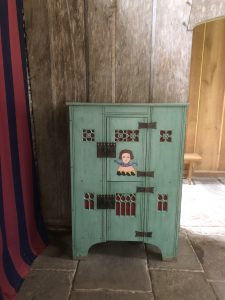 After the victory at Tewkesbury in 1471, Roger was charged by King Edward with the pursuit of Jasper Tudor, Duke of Bedford, but himself falling into Jasper’s hands, was summarily executed at Chepstow. He could hardly have expected mercy from Owain’s son, but the court poets were incensed. Calling on the family to avenge him, they ‘cursed Jasper’s marrow for this wicked deed … May [we] see the traitor’s skullbone/Used in Tretower to tune the harpstring,’ they sang.
After the victory at Tewkesbury in 1471, Roger was charged by King Edward with the pursuit of Jasper Tudor, Duke of Bedford, but himself falling into Jasper’s hands, was summarily executed at Chepstow. He could hardly have expected mercy from Owain’s son, but the court poets were incensed. Calling on the family to avenge him, they ‘cursed Jasper’s marrow for this wicked deed … May [we] see the traitor’s skullbone/Used in Tretower to tune the harpstring,’ they sang.
The patronage of poets endured under Roger’s son, Sir Thomas, who was unstintingly eulogised by Lewis Glyn Cothi and others, both for his courage in arms and for his liberal hospitality. Though a supporter of Richard III, he was luke-warm in the months before Bosworth, earning himself a general pardon from Henry VII.
His descendants never ascended in rank, but lived the relatively obscure lives of minor gentry, occasionally filling the office of High Sheriff, until in 1783 Charles Vaughan sold Tretower to a local farmer. By the 1850s it had been entirely given over to agricultural purposes, and the roof of the north range was on the point of collapse.
The Boy’s Head and the Snake
The figures on the hanging are always identifiable by their heraldry, which Cadw have put to excellent use at Tretower. Dafydd Gam, Roger Vaughan and William Herbert all wear armorial surcoats. Dafydd bears Argent three cocks gules, William Herbert Per pale azure and gules, three lions rampant argent. As for Roger, his coat of arms is the distinctive Sable three boys’ heads, couped at the neck proper, a snake about the neck of each one Vert – or so it appears here. The arms of Vaughan were inconsistently blazoned among the various branches. The tinctures vary and sometimes a chevron argent appears between the heads. (Michael Siddons ed., Visitations by the Heralds in Wales, Harleian Society, New Series XIV, London, 1996, pp.43, 54, 90; Burke’s General Armory.)
According to A.C. Fox-Davies (A Complete Guide to Heraldry, London, 1929, p.169), ‘The boy’s head will seldom be found as a charge except in Welsh coats, of which the arms of Vaughan and Price are examples’. To this list I would add the Watkins of Cwrt Robert in Tregear, Monmouthshire. Their ancestor, Lewis ap Gwatkyn of Painscastle, a contemporary and perhaps near relation of Roger of Tretower, is described by Lewis Glyn Cothi as a scion of the Vaughans of Bredwardine. (See http://www.rupertwilloughby.co.uk/gleanings/upper-house-painscastle-radnorshire-a-court-fit-for-king-arthur/.)
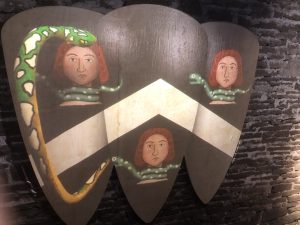 But why the snake? It commemorates their supposed descent from Moreiddig Warwyn (‘white neck’), and thence from Drymbenog ap Maenarch, lord of Brycheiniog. Legend has it that Moreiddig emerged from the womb with a viper entwined around his neck, a sure sign of his princely birth. In reality it may have been the umbilical cord, rather than a viper, that was so entwined. Moreiddig was also the fychan or ‘second born’ son. The surname Fychan, adopted by his descendants, was subsequently anglicised as Vaughan.
But why the snake? It commemorates their supposed descent from Moreiddig Warwyn (‘white neck’), and thence from Drymbenog ap Maenarch, lord of Brycheiniog. Legend has it that Moreiddig emerged from the womb with a viper entwined around his neck, a sure sign of his princely birth. In reality it may have been the umbilical cord, rather than a viper, that was so entwined. Moreiddig was also the fychan or ‘second born’ son. The surname Fychan, adopted by his descendants, was subsequently anglicised as Vaughan.
I particularly loved the projections that were automatically triggered in one of the old storerooms of the north range, an animated viper appearing from behind a row of shields to give an account of the house and family; or it was an almost tangible Lewis Glyn Cothi and a cast of animals, explaining their connection with the Mabinogion (an edition of which is on sale in the Tretower shop). My young son was enchanted, and so were the many other young visitors, who joyfully scaled the ramparts and coursed through the empty rooms in their unending games of hide and seek.
